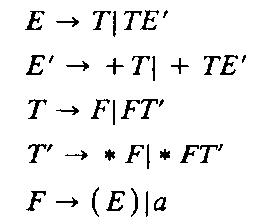

To make the table more compact, only the non-terminal rows are commonly displayed, since the action is the same for terminals.Ĭoncrete example Set up If the parser cannot perform a valid transition, the input is rejected (empty cells). įor a given context-free grammar, the parser attempts to find the leftmost derivation. According to Waite and Goos (1984), LL( k) grammars were introduced by Stearns and Lewis (1969). LL grammars can also be parsed by recursive descent parsers.

LL parsers are table-based parsers, similar to LR parsers. LL grammars, particularly LL(1) grammars, are of great practical interest, as parsers for these grammars are easy to construct, and many computer languages are designed to be LL(1) for this reason. Īgainst the popular misconception, LL(*) parsers are not LLR in general, and are guaranteed by construction to perform worse on average (super-linear against linear time) and far worse in the worst-case (exponential against linear time). It has been suggested that LL(*) parsers are better thought of as TDPL parsers. The class of grammars parsable by the LL(*) strategy encompasses some context-sensitive languages due to the use of syntactic and semantic predicates and has not been identified. An LL(finite) parser can parse an arbitrary LL(k) grammar optimally in the amount of lookahead and lookahead comparisons.


LL(*) and LL(finite) parsers are functionally more closely resemblant to PEG parsers. A parser is called LL(*)/LL(finite) if it uses the LL(*)/LL(finite) parsing strategy. Two nomenclative outlier parser types are LL(*) and LL(finite). For every LLR grammar there exists an LLR parser that parses the grammar in linear time. LLR grammars are a proper superset of LL(k) grammars for any k. A corollary of this is that not all context-free languages can be recognized by an LL( k) parser.Īn LL parser is called LL-regular if it parses precisely the class of LL-regular languages. The set of LL( k) languages is properly contained in that of LL( k+1) languages, for each k ≥ 0. A formal language is called an LL( k) language if it has an LL( k) grammar. A grammar is called an LL( k) grammar if an LL( k) parser can be constructed from it. It parses the input from Left to right, performing Leftmost derivation of the sentence.Īn LL parser is called an LL( k) parser if it uses k tokens of lookahead when parsing a sentence. In computer science, an LL parser (Left-to-right, leftmost derivation) is a top-down parser for a restricted context-free language. A top-down parser that parses input from left to right


 0 kommentar(er)
0 kommentar(er)
